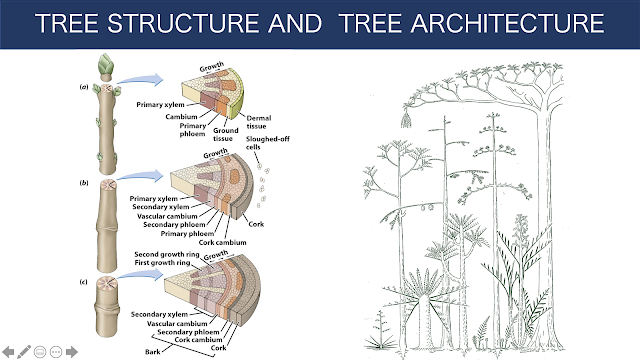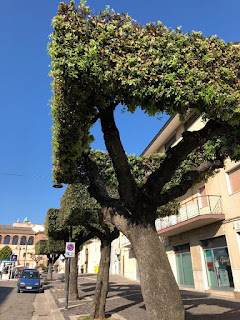樹木建構學 tree architecture
樹木結構與樹木建構
Tree structure 樹木結構 : 大部份植物學家都會使用「structure」這一詞來描述植物的構造與功能,在樹木修剪上,常見到樹木結構這詞,主要講的樹木的力學上是否為安全的。
Tree architecture 樹木建構 :「architecture」是建築的意思,直接翻譯「樹木建築」這是什麼意思? 主要是研究樹木的生長方式與形態,能夠了解樹木的過去與預測未來的生長。
樹木建構學
將樹木分為具有相似特徵(分枝類型、分枝方向、延伸生長類型、開花位置)。有人認為樹木生長有無限可能的組合,但研究表明,世界上所有樹木可以區分為23種生長模式。
樹木建構領域科學家大多住在法國與加拿大,因此資料大多以法文出版。
樹木建構學
葉子形態特徵建立多項式函數 進行葡萄樹品種辦認
葉子形態特徵建立多項式函數 進行葡萄樹品種辦認
有沒有使用過植物辨別App如「PlantSnap」,「形色」,出錯率很高,尤其植物識別能力特強的人,覺的那種App根本是垃圾,可能是training data 量還不夠,但會初學者來說是很有趣的。
目前冷泉港實驗室,利用不同發育時期的葉片形態建立函數,會比只有辦識單個葉片的資料還精準,可以精細到辦識不同品種的葡萄。未來可能是用這方法來訓練電腦,讓植物辨別App可以達到更精準。
資料來源:
Cold spring harbor laboratory
Abigail E. Bryson, Maya Wilson Brown, Joey Mullins, Wei Dong, Keivan Bahmani, Nolan Bornowski, Christina Chiu, Philip Engelgau, Bethany Gettings, Fabio Gomezcano, Luke M. Gregory, Anna C. Haber, Donghee Hoh, Emily E. Jennings, Zhongjie Ji, Prabhjot Kaur, Sunil K. Kenchanmane Raju, Yunfei Long, Serena G. Lotreck, Davis T. Mathieu, Thilanka Ranaweera, Eleanore J. Ritter, Rie Sadohara, Robert Z. Shrote, Kaila E. Smith, Scott J. Teresi, Julian Venegas, Hao Wang, McKena L. Wilson, Alyssa R. Tarrant, Margaret H. Frank, Zoë Migicovsky, Jyothi Kumar, Robert VanBuren, Jason P. Londo, Daniel H. Chitwood
除草劑嘉磷賽影響樹木健化強度
除草劑嘉磷賽影響樹木健化強度
Glyphosate can damage trees and affect hardiness
The economic cost to the U.S. nursery industry of bark cracking is conservatively estimated at $6.6 million annually (or 2.5% of finished inventory). This estimate doesn’t include $14 million in landscape tree failures due to bark cracking. The estimates continue a pattern of increased severity and frequency of bark cracking since 2004. At the same time, consumer preference for faster-working glyphosate products was driving production of various surfactants to break down the cuticle of plants and increase rate and amount of glyphosate uptake.
In 2005, researchers at Ohio State University speculated that bark cracking was not solely related to cold injury, but that the absorption of glyphosate into thin or pigmented bark was also increasing with the use of new surfactants. Glyphosate is the most common herbicide, but little literature exists regarding its safe or correct use around trees. Horticultural Research Institute funded research at Ohio State, which is evaluating glyphosate’s role in crown dormancy disruption and woody tissue hardiness in relation to species, time and frequency of application and glyphosate formulation.
Use with caution
Generally, pre-emergence herbicides should be the backbone of a nursery or landscape weed-control program. Achieving satisfactory weed control generally requires repeated applications of one or more pre-emergence herbicides, but at least two applications (spring and fall) are recommended in nursery fields and landscape settings.
Post-emergence herbicides can be used with extreme caution and forethought. Post-emergence herbicides are the big guns in your weed-control program, so limit their use to rescue treatments. Always avoid contacting green bark of ornamentals with post-emergence sprays. Be especially careful with newer glyphosate formulations that contain surfactants to increase penetration into green tissue. Glyphosate formulations with increased surfactants should be avoided in nursery production due to an increase in incidence of injury problems.
Never use glyphosate for sucker removal. Scythe (pelargonic acid) is the only broad-spectrum post-emergence labeled for sucker removal. At OSU we have identified many risky grower and landscaper practices such as reducing pre-emergence applications and making applications (1 quart per acre) as frequent as eight times a season (every 1 1/2 weeks), removing suckers and adventious shoots with glyphosate, applying glyphosate shortly after mechanical removal of suckers and repeated drift exposure of glyphosate to trees.
Sucker removal
Herbicides containing glyphosate should be sprayed before sucker removal, not after. It is best to remove the sucker within a few hours of spraying. Using systemic herbicides such as glyphosate after mid-July is not recommended. Fall is when plants accumulate stores in the roots and systemic post-emergence applications are recommended for killing stumps and perennial root systems. After mid-July use only Scythe for sucker removal and any post-emergence treatments.
The best way to remove suckers is with a sprout inhibitor such as Tre-Hold Sprout Inhibitor A-112, Tre-Hold RTU or other formulations containing naphthaleneacetic acid (NAA) to inhibit the development of adventitious shoots. Mechanical removal of suckers, another common practice, has been shown to increase sprouting, as it creates a wound response in the plant and initiates more shoots. Paint or spray the NAA products onto pruning cuts after sprouts are removed.
New products are confusing, not better
Roundup (glyphosate) has been labeled for ornamental use for more than 30 years. It controls weeds by inhibition is of 3-enol-pyruvylshikimate-5-phosphate (EPSP) synthase. It has been used extensively due to its numerous attributes: limited soil activity; non-volatile, broad-spectrum, systemic, low environmental impact; ability to translocate throughout the plant; ease of use; and low mammalian toxicity. Roundup went off of patent in 2000, opening the market to generics. In 2007, there were 45 generic glyphosate products registered for ornamentals. Each uses surfactants with varying loads. Research at Ohio State University to study glyphosate products found a significant reduction in trunk cold hardiness with the use of newer (increased surfactant) formulations.
Nursery growers adopted standard practices of glyphosate applications before 2000 when Roundup Original was used. Trying to find a product like the original Roundup is like entering a maze. Roundup originally was sold with isopropylamine salt. Today, you find glyphosate products labeled with four salts: isopropylamine (ipa), trimethylsulfuronium, diammonium and potassium. There are glyphosate products with three kinds of surfactants and full partial or no load, nonionic, cationic (polyoxyethylene tallow amine) and transorb surfactant system. Concentrations are also different. Products are labeled using acid equivalents or as active ingredient, making it very difficult to compare products for activity. In short, buying glyphosate has become one of those “mystifying experiences” -- where you begin to wonder if Amelia Earhart and other incidences in the Bermuda Triangle are not somehow linked to glyphosate.
Consumers tend to want a faster-working product, so makers of glyphosate products focused on changing surfactants to improve plant cuticle breakdown.
Sub-lethal dosing
Glyphosate is broken down within the soil, but once in the phloem of a plant, it may take years to break down. Exposure to an ornamental through green bark is considered a sub-lethal dose and can injure the plant. Absorption of glyphosate is possible with thin bark or bark with pigment. Injury symptoms from sub-lethal doses of glyphosate may not be present up to two years after absorption of the glyphosate.
Several symptoms occur when a woody plant is exposed to a sub-lethal doses of glyphosate: witches broom, stunting, bark cracking or splitting, loss of apical dominance, individual dead limbs, chlorosis and death. Glyphosate injury is difficult to diagnose for two main reasons: the amount of time the herbicide is contained within the plant and the numerous symptoms that may occur. You can minimize the risk of glyphosate injury by calibrating spray equipment, using correct amounts, limiting use, reducing drift and overspray and using shields when spraying around thin-barked trees.
How glyphosate works
Inhibition EPSP synthase by glyphosate leads to an accumulation of shikimic acid, depletion of aromatic amino acids and change in phenolics in plants. Pools of phenolic compounds derived from aromatic amino acids are reduced. Phenolic compounds are plant-based phytochemicals. Phenolic compounds, which are synthesized primarily from products of the shikimic acid pathway, serve as defenses against herbivores and pathogens. Glyphosate kills plants by blocking a step in the shikimic pathway.
Glyphosate is not metabolized in higher plants. It is rapidly translocated to the roots where it is stored along with sugars flowing to the roots in summer and fall. In spring when the flow of sugars is reversed, glyphosate can be translocated to meristematic regions to cause glyphosate carryover injury.
A direct relationship exists between the accumulation of phenolic compounds and increased cold hardiness in some plant species. Recent studies have shown that low temperatures cause a direct increase in flavonoids, phenololin and tannins in woody plants. If you apply glyphosate for one or two years even in single, low doses up to eight times a season, you’re severely compromising cold hardiness development in roots, crowns and trunks.
In 2005, when
What to use
When glyphosate is necessary around ornamental plants, use a product that has no adjuvant load. These products indicate you need to add an adjuvant, but don’t. The products that have a full load of adjuvant are the worse around ornamental plants with green bark as these already have a surfactant (you have no idea what) that will increase their uptake into your plants.
{sidebar id=2}
- Hannah Mathers
Hannah Mathers is associate professor and state extension specialist nursery/landscape,
July 2008
Registered glyphosate products, 2006 | |||
Trade name | Manufacturer | Active ingredients | Adjuvant load* |
Backdraft | BASF | imazaquin + glyphosate-ipa | None |
Campaign | Monsanto | glyphosate-ipa + 2,4-D-ipa | None |
Cornerstone | Agriliance | glyphosate-ipa | Partial |
Engame | UAP | glyphosate-AMADS | Partial |
Expert | Novartis | s-metolachlor + atrazine + glyphosate-ipa | None |
Extreme | BASF | imazethapyr + glyphosate-ipa | None |
Fallowmaster | Monsanto | glyphosate-ipa + dicamba acid | None |
Fallow Star | Albaugh | glyphosate-ipa + dicamba acid | None |
FieldMaster | Monsanto | acetochlor + atrazine + glyphosate-ipa | None |
Gly-Flo | Micro Flo | glyphosate-ipa | Partial |
Glyfos | Cheminova | glyphosate-ipa | Partial |
Glyphos X-tra | Cheminova | glyphosate-ipa | Full |
Glyphomax | Dow | glyphosate-ipa | Partial |
Glyphomax Plus | Dow | glyphosate-ipa | Full |
Glyphosate Herb | DuPont | glyphosate-ipa | Partial |
Glyphosate Orig. | glyphosate-ipa | Partial | |
Glypro | Dow | glyphosate-ipa | None |
Glypro Plus | Dow | glyphosate-ipa | Full |
Gly Star 5 | Albaugh | glyphosate-ipa | Partial |
Gly Star Original | Albaugh | glyphosate-ipa | Partial |
Gly Star Plus | Albaugh | glyphosate-ipa | Full |
Landmaster BW | Monsanto | glyphosate-ipa + 2,4-D-ipa | None |
Land Star | Albaugh | glyphosate-ipa + 2,4-D-ipa | None |
Protocol | Monsanto | glyphosate-ipa | Partial |
Rattler | glyphosate-ipa | Partial | |
ReadyMaster ATZ | Monsanto | atrazine + glyphosate | None |
Rodeo | Monsanto | glyphosate-ipa | None |
Roundup Custom | Monsanto | glyphosate-ipa | None |
Roundup Original | Monsanto | glyphosate-ipa | Partial |
RU Original RT | Monsanto | glyphosate-ipa | Partial |
RU SoluGran | Monsanto | glyphosate-NH3 | None |
RU/Private labels | Various | glyphosate-ipa | Partial |
Roundup Ultra | Monsanto | glyphosate-ipa | Full |
Roundup Ultra RT | Monsanto | glyphosate-ipa | Full |
RU UltraDry | Monsanto | glyphosate-NH3 | Full |
RU UltraMax | Monsanto | glyphosate-ipa | Full |
Silhouette | Various | glyphosate-ipa | Partial |
Touchdown 5 | Syngenta | glyphosate-tms | Partial |
Touchdown 3 | Syngenta | glyphosate - 2(NH3) | Full |
* Full = No additional Non-Ionic Surfactant ( | |||
Partial = Additional | |||
None = Additional | |||
森林的神 Tāne Mahuta
樹木修剪工作,高壓電意外截肢 Medschoolposts
楊宗凡覺得有趣──在橘子會吃醋。
樹木結構與樹木建構 Tree structure and Tree architecture
樹木結構與樹木建構
人工智能會取代樹木修剪工作嗎?
人工智能會取代樹木修剪工作嗎?
人工智能發展會讓有些行業受衝擊如醫生、律師、會計師等等,會讓這些行業工作機會大為減少,修剪樹木呢? 現今人工智能還不具備一般常識,如要修剪樹木,應該要在那裡修剪比較安全,人工智能還沒辦法把所有情況模擬出來,出錯的機會非常高。人工智能要有常識是現今研究主要方向。
樹木工作要用人工智能機器人取代,可能還要30年以上,除了要具備常識外,還要有樹木學專業知識,要人腦等級的 AI , 機械機器人製造技術也要達到可以上樹木工作等級(要耐衝擊、機體防水),才會有可能。
資料來源:
Ernest Davis and Gary Marcus.2015. cacm.acm.org. David Dunning DARPA/12O.
植物氣孔打開與關閉機制
植物氣孔打開與關閉機制
樹木構型 Archi type
排灣族稱vacinga為雀榕 cite 鄭漢文
剷壞根留好幹 220歲老榕成了「浮在空中的樹」
剷壞根留好幹 220歲老榕成了「浮在空中的樹」
剷壞根留好幹 220歲老榕成了「浮在空中的樹」
2020-06-20 15:58:00
〔記者彭健禮/苗栗報導〕苗栗縣卓蘭鎮上新里與內灣里交接處一棵逾220歲老榕樹,為縣府列冊受保護的老樹。這棵老榕樹去年確診染褐根病,苗栗縣政府農業處展開「外科手術」救治,切除染病樹基部、保留健康樹體的上半部,再以支架支撐,成了一棵「浮在空中的樹」,讓居民都稱奇。
農業處表示,搶救老榕樹工程於15日開始施作,預計本週末完成新設支撐架、外科手術切除染病部位、導根施作等工項,再進行疫病土壤薰蒸消毒作業2星期以上,整個工期至11月30日止,完工後會有近3年的維護保固期,以確保老榕樹能恢復生機。
老榕樹位山尾伯公廟旁,伴隨當地里民逾百年,承載當地居民的共同記憶,里民去年發現老榕樹出現黃化、萎凋、新生葉變小稀疏的情形,經陳情農業處,診斷確診染褐根病,里民希望縣府能原地搶救老榕樹,避免再失去地方重要綠色文化資產。
農業處表示,因救治工程期間會有機具進出,請民眾勿接近和擅自進入工區,以確保生命安全,並維護老榕樹搶救品質。農業處也將不定期將老榕樹搶救過程及生長狀態發布周知,讓民眾一起參與保育,一起為老榕樹祈福。
24°18'00.5"N 120°50'10.3"E
資料來源:

































